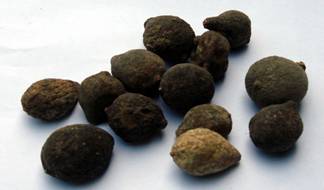NARINGIN
Identification
Ingredient |
Naringin |
Structure:
![Naringin, 7-(2-O-(6-deoxy-alpha-L-mannopyranosyl)-beta-D-glucopyranosyloxy)-2,3-dihydro-4',5,7-trihydroxyflavone, 7-[[2-O-(6-Deoxy-alpha-L-mannopyranosyl)-beta-D-glucopyranosyl]oxy]-5-hydroxy-2(S)-(4-hydroxyphenyl)-4H-1-benzopyran-4-one CAS #: 10236-47-2](limonin_clip_image001.gif) |
Synonyms |
4,5,7-Trihydroxyflavanone 7-rhamnoglucoside, Naringenin-7-neohesperidoside |
Molecular Formula |
C27H32O14 |
Molecular Weight |
580.54 |
CAS no. |
10236-47-2 |
EINECS |
233-566-4 |
Description
Naringin belongs to a group of chemicals called bioflavonoids, which are colorful pigments found in plants. They were discovered by Nobel Prize-winning biochemist Albert Szent-Gyorgi, who labeled them "vitamin P" (although they were subsequently stripped of their vitamin status). Bioflavonoids belong to a larger group of phytochemicals called polyphenols. Key polyphenols include phenolic acids, flavonoids, stilbenes, and lignans. Flavonoids are the most abundant polyphenols in our diets.
Distribution
Naringin is a flavonoid extracted from grapefruit and other citrus fruits (albeit in lower amounts). Its content is up to 8% in some kinds of grapefruit in China when it is immature, but in some varieties, the content is nearly zero.
In Spain, University of Murcia reported that the distribution of the flavanones naringin and neohesperidin has been analyzed during the development of the leaves, flower buds, and fruits of Citrus aurantium. These flavonoids are at maximum concentration in the organs studied during the logarithmic phase of growth, gradually decreasing until the organs reach maximum development. However, this decrease in the naringin and neohesperidin concentration in leaves, flower buds, and fruits is due to a dilution of the flavonoids caused by cell growth, because total content per organ continues to increase. The levels of neohesperidin are always greater than those of naringin, although the ratio between the relative concentrations is different in the three organs studied. Leaves have the highest ratios, varying between 8.83 and 5.18, followed by flowers (3.15-1.85), and fruits (2.23-1.02). These observations suggest different relationships between the respective enzymic activities in their biosynthetic pathway.
Application
Naringin is a natural chemical compound known as a bioflavanoid found in grapefruit, giving it its bitter flavor. Hence,the food industry, however, uses naringin as a bitter in "tonic" beverages, bitter chocolate, ice cream, and ices.
This bioflavonoid has antioxidant and antifungal properties, and as such may help prevent cancer and atherosclerosis (hardening of arteries), as well as a number of other ailments,such as Herpes ,Diabetes,Alcoholism, Heart failure, Chronic venous insufficiency,Bruising.
Naringin also works synergistically with other nutrients, increasing the bio-availability (how much nutrient is absorbed by the body) and therefore maximizing the health benefits of these nutrients.
Of course,it is important to note this citrus extract interferes with enzyme activity in the intestines, and therefore can inhibit the breakdown of certain drugs. That is why you should consult with your physician if you are on any medication before eating grapefruit.
Availability
Commercial Naringin is obtained by extraction from immature fruit of Citrus Grandis Osbeck.

Dried immature fruit of Citrus Grandis Osbeck
Warning:
Above information is only knowledge,not an instruction of usage for this product. The owner of this webiste should not be responsible for any damage because of misuse of the product.
|



